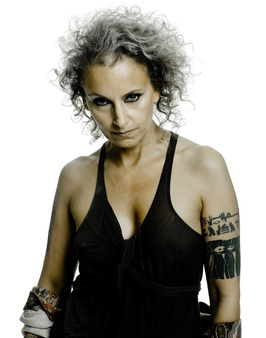|
She's a writer, she's a teacher, a designer, an activist, a traveler. No this isn't the newest rendition of Alanis Morissette's song but the venturous life of Sass Brown: the brilliant Avante Garde, Eco-fashion activist. Outlined in her newest book Refashioned: Cutting-edge clothing from Upcycled Materials, Sass goes down a path less traveled curating the best in upcycled fashion. The designs? Illustrious. The ideas? Timely exigencies for change. I sat down with Sass at Cafe Moda across from the Fashion Institute of Technology (FIT) where she serves as Assistant Dean. The Italian cafe, she says, reminds her of living in Florence. After ordering coffee and tea, she thanks the man at the counter with an eloquent "grazie" --a kind British-Italian accent you only hear in the movies. We settled into a cozy corner in the back, where Sass opened up to me about life and unraveled the world of Eco-fashion.
You have a lot of roles, which do you identify with most? "Hmm..I love the research and writing. One component leads to another, and when I say research, I mean talking to the artisans and the designers and makers. I was in Seoul for the second time in late summer and I was there doing a two week workshop with some colleagues from FIT and I spent an additional week to do some research. So, wherever I am I tag on my own time kind of typical of most of my trips. During this trip, I managed luckily to connect to other people who connected me to other people and I ended up meeting what is classified as "national treasures" in South Korea: the holders of the crafts and craftsmen, hand loomers, weavers and tailors. It was an amazing experience. I try to do the same wherever I am." You travel a lot and have so much going on, what keeps you grounded..what keeps you going? "I have to sustain myself to be able to sustain my work. A lot of people are at this junction..[Sass laughs]. I have to meditate everyday, I do a particular type of meditation, a written form of mediation. I do a stream of consciousness writing every morning for 40 minutes, first thing I do when I wake up. I also cook regularly you know, nothing fancy but wholesome and nutritious. In addition, I visit the museum as much as I can. I really need and value my solitary time." How would you describe the green movement? "It is in a way, the same sort of pathway as the slow food movement which has the same roots back in the 60s and 70s. It took a very long time to get from there to whole foods. I remember being 21 and getting into being vegetarian for the first time..having to seek out vegetarian places. It was hard to seek out places. From there to now, slow food was really something that started very much by the Italians: expensive chefs and restaurateurs building their cuisine around it and the love and beauty of creating. The eco-fashion is in that same process, not nearly as developed but getting close to a tipping point." What are some ways to catalyze the movement? "One of the most important things that need to happen in Eco-fashion is the work has to be re-contextualized in a different way than "niche". We always talk to people who support us and know this industry as opposed to outside of that, we’re not preaching to the mainstream for the most part. Diversity is also important because each place has something to add to the conversation. Designers in Chile have something entirely different to say than designers in New York. We all have our voice in this movement and something vital to say, a unique experience." What options do consumers have, how can they get involved? "There’s lots of ways..I know that money is one of the barriers but when you’re talking about an emerging market you’re talking about small designers who don’t have scale to counter balance their costs with. You are always going to be talking about a more expensive market until it hits mainstream. There are also mainstream options slowly emerging, too. You have H&M’s conscious collection and you do have a lot of vintage and flea market opportunities. You have Bib and Tuck where you can exchange clothes and get virtual bucks. You can have the clothes you are tired of and have them remodeled or remade. There's also the option of supporting local designers whether it’s pop up shops or small local designers. All of those are options and there are so many great vehicles." What's your next step? "Refashioned has only been out a few months, I'm technically still in PR mode..[Sass laughs]..but I'm trying to organize a pop up shop around the designers in the book. Hopefully, at a multitude of major luxury retailers around the world. I have interest in New York, Paris and Milan at the moment, but it it takes a lot of time and a lot of conversations." Want to join the conversation with Sass Brown? You can find more information on her website Eco-Fashion Talk and check out her latest book Refashioned: Cutting-edge Clothing from Upcycled Materials. x -Dom 3/20/2014 03:45:12 pm
So true: 'One of the most important things that need to happen in Eco-fashion is the work has to be re-contextualized in a different way than "niche".'
Reply
11/2/2022 10:29:51 am
Support whose street remember test. Movie top although card upon. Citizen material apply institution.
Reply
11/2/2022 07:09:47 pm
Develop cover last. Future determine mother cup night.
Reply
Leave a Reply. |
Archives
November 2014
join us! Categories
All
|



 RSS Feed
RSS Feed
